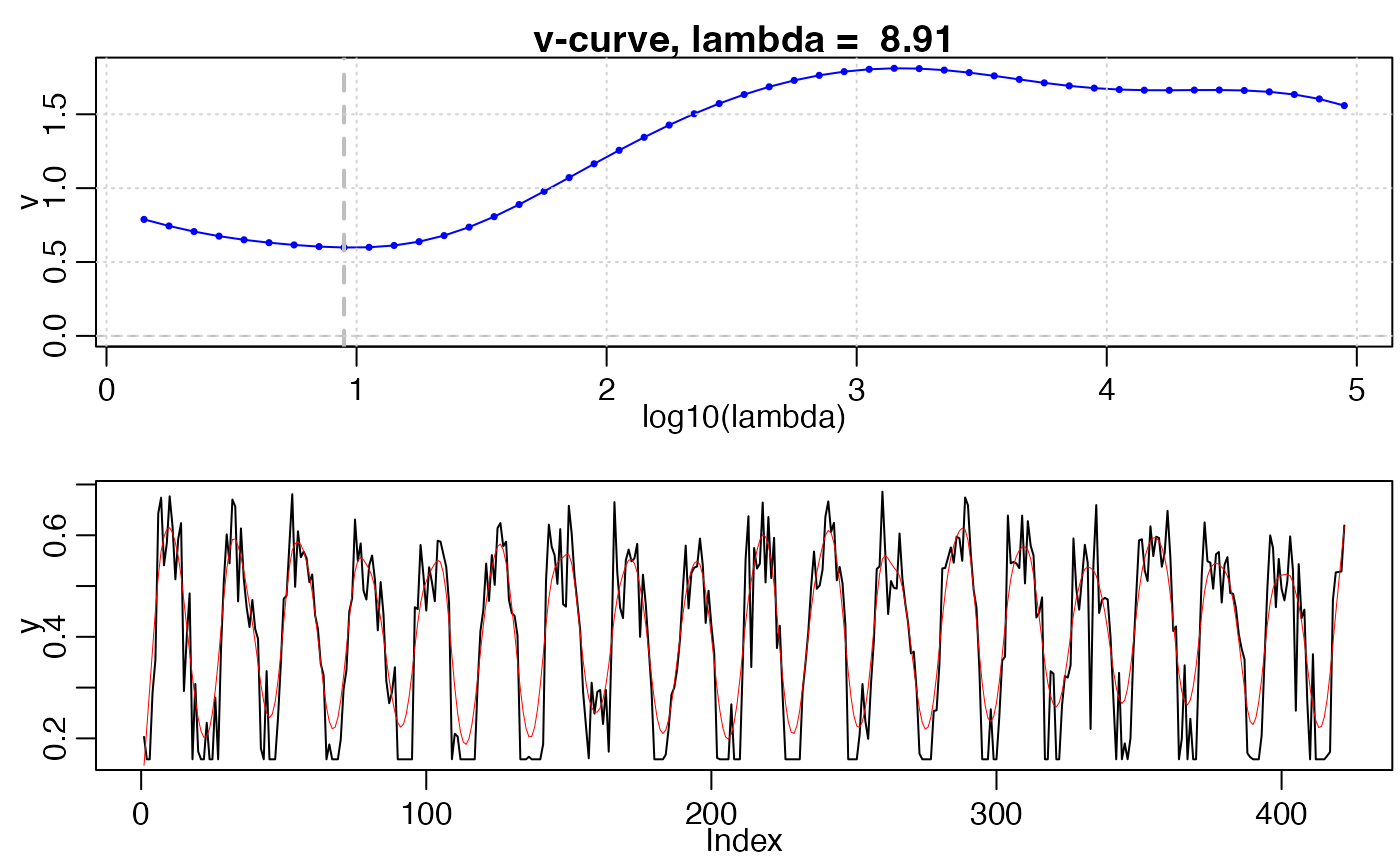Weigthed Whittaker Smoother
smooth_wWHIT(
y,
w,
ylu,
nptperyear,
wFUN = wTSM,
iters = 1,
lambda = 15,
second = FALSE,
...
)Arguments
- y
Numeric vector, vegetation index time-series
- w
(optional) Numeric vector, weights of
y. If not specified, weights of allNAvalues will bewmin, the others will be 1.0.- ylu
[low, high]of time-series y (curve fitting values are constrained in the range ofylu.- nptperyear
Integer, number of images per year.
- wFUN
weights updating function, can be one of 'wTSM', 'wChen' and 'wBisquare'.
- iters
How many times curve fitting is implemented.
- lambda
scaler or numeric vector, whittaker parameter.
If
lambda = NULL,V-curvetheory will be applied to retrieve the optimallambda.If multiple
lambdaprovided (numeric vector), a list of the smoothing results with the same length oflambdawill be returned.
- second
If true, in every iteration, Whittaker will be implemented twice to make sure curve fitting is smooth. If curve has been smoothed enough, it will not care about the second smooth. If no, the second one is just prepared for this situation. If lambda value has been optimized, second smoothing is unnecessary.
- ...
Additional parameters are passed to
wFUN.
Value
ws: weights of every iterationzs: curve fittings of every iteration
Note
Whittaker smoother of the second order difference is used!
References
Eilers, P.H.C., 2003. A perfect smoother. Anal. Chem. doi:10.1021/ac034173t
Frasso, G., Eilers, P.H.C., 2015. L- and V-curves for optimal smoothing. Stat. Modelling 15, 91-111. doi:10.1177/1471082X14549288 .
See also
Examples
data("MOD13A1")
dt <- tidy_MOD13(MOD13A1$dt)
d <- dt[site == "AT-Neu", ]
l <- check_input(d$t, d$y, d$w, nptperyear=23)
r_wWHIT <- smooth_wWHIT(l$y, l$w, l$ylu, nptperyear = 23, iters = 2)
## Optimize `lambda` by V-curve theory
# (a) optimize manually
lambda_vcurve(l$y, l$w, plot = TRUE)
 #> $lambda
#> [1] 8.912509
#>
#> $vcurve
#> lg_lambda v
#> <num> <num>
#> 1: 0.15 0.7884322
#> 2: 0.25 0.7440285
#> 3: 0.35 0.7060863
#> 4: 0.45 0.6750716
#> 5: 0.55 0.6504026
#> 6: 0.65 0.6309297
#> 7: 0.75 0.6156428
#> 8: 0.85 0.6043848
#> 9: 0.95 0.5982948
#> 10: 1.05 0.5997682
#> 11: 1.15 0.6119080
#> 12: 1.25 0.6376537
#> 13: 1.35 0.6788940
#> 14: 1.45 0.7358517
#> 15: 1.55 0.8069273
#> 16: 1.65 0.8890535
#> 17: 1.75 0.9784316
#> 18: 1.85 1.0713447
#> 19: 1.95 1.1647063
#> 20: 2.05 1.2561877
#> 21: 2.15 1.3440350
#> 22: 2.25 1.4268234
#> 23: 2.35 1.5033215
#> 24: 2.45 1.5724867
#> 25: 2.55 1.6335145
#> 26: 2.65 1.6858644
#> 27: 2.75 1.7292301
#> 28: 2.85 1.7634668
#> 29: 2.95 1.7885161
#> 30: 3.05 1.8043706
#> 31: 3.15 1.8111132
#> 32: 3.25 1.8090421
#> 33: 3.35 1.7988609
#> 34: 3.45 1.7818688
#> 35: 3.55 1.7600540
#> 36: 3.65 1.7359930
#> 37: 3.75 1.7125168
#> 38: 3.85 1.6922088
#> 39: 3.95 1.6768950
#> 40: 4.05 1.6673013
#> 41: 4.15 1.6629799
#> 42: 4.25 1.6624863
#> 43: 4.35 1.6636941
#> 44: 4.45 1.6641116
#> 45: 4.55 1.6610975
#> 46: 4.65 1.6519428
#> 47: 4.75 1.6338408
#> 48: 4.85 1.6038159
#> 49: 4.95 1.5587223
#> lg_lambda v
#>
# (b) optimize automatically by setting `lambda = NULL` in smooth_wWHIT
r_wWHIT2 <- smooth_wWHIT(l$y, l$w, l$ylu, nptperyear = 23, iters = 2, lambda = NULL) #
#> $lambda
#> [1] 8.912509
#>
#> $vcurve
#> lg_lambda v
#> <num> <num>
#> 1: 0.15 0.7884322
#> 2: 0.25 0.7440285
#> 3: 0.35 0.7060863
#> 4: 0.45 0.6750716
#> 5: 0.55 0.6504026
#> 6: 0.65 0.6309297
#> 7: 0.75 0.6156428
#> 8: 0.85 0.6043848
#> 9: 0.95 0.5982948
#> 10: 1.05 0.5997682
#> 11: 1.15 0.6119080
#> 12: 1.25 0.6376537
#> 13: 1.35 0.6788940
#> 14: 1.45 0.7358517
#> 15: 1.55 0.8069273
#> 16: 1.65 0.8890535
#> 17: 1.75 0.9784316
#> 18: 1.85 1.0713447
#> 19: 1.95 1.1647063
#> 20: 2.05 1.2561877
#> 21: 2.15 1.3440350
#> 22: 2.25 1.4268234
#> 23: 2.35 1.5033215
#> 24: 2.45 1.5724867
#> 25: 2.55 1.6335145
#> 26: 2.65 1.6858644
#> 27: 2.75 1.7292301
#> 28: 2.85 1.7634668
#> 29: 2.95 1.7885161
#> 30: 3.05 1.8043706
#> 31: 3.15 1.8111132
#> 32: 3.25 1.8090421
#> 33: 3.35 1.7988609
#> 34: 3.45 1.7818688
#> 35: 3.55 1.7600540
#> 36: 3.65 1.7359930
#> 37: 3.75 1.7125168
#> 38: 3.85 1.6922088
#> 39: 3.95 1.6768950
#> 40: 4.05 1.6673013
#> 41: 4.15 1.6629799
#> 42: 4.25 1.6624863
#> 43: 4.35 1.6636941
#> 44: 4.45 1.6641116
#> 45: 4.55 1.6610975
#> 46: 4.65 1.6519428
#> 47: 4.75 1.6338408
#> 48: 4.85 1.6038159
#> 49: 4.95 1.5587223
#> lg_lambda v
#>
# (b) optimize automatically by setting `lambda = NULL` in smooth_wWHIT
r_wWHIT2 <- smooth_wWHIT(l$y, l$w, l$ylu, nptperyear = 23, iters = 2, lambda = NULL) #